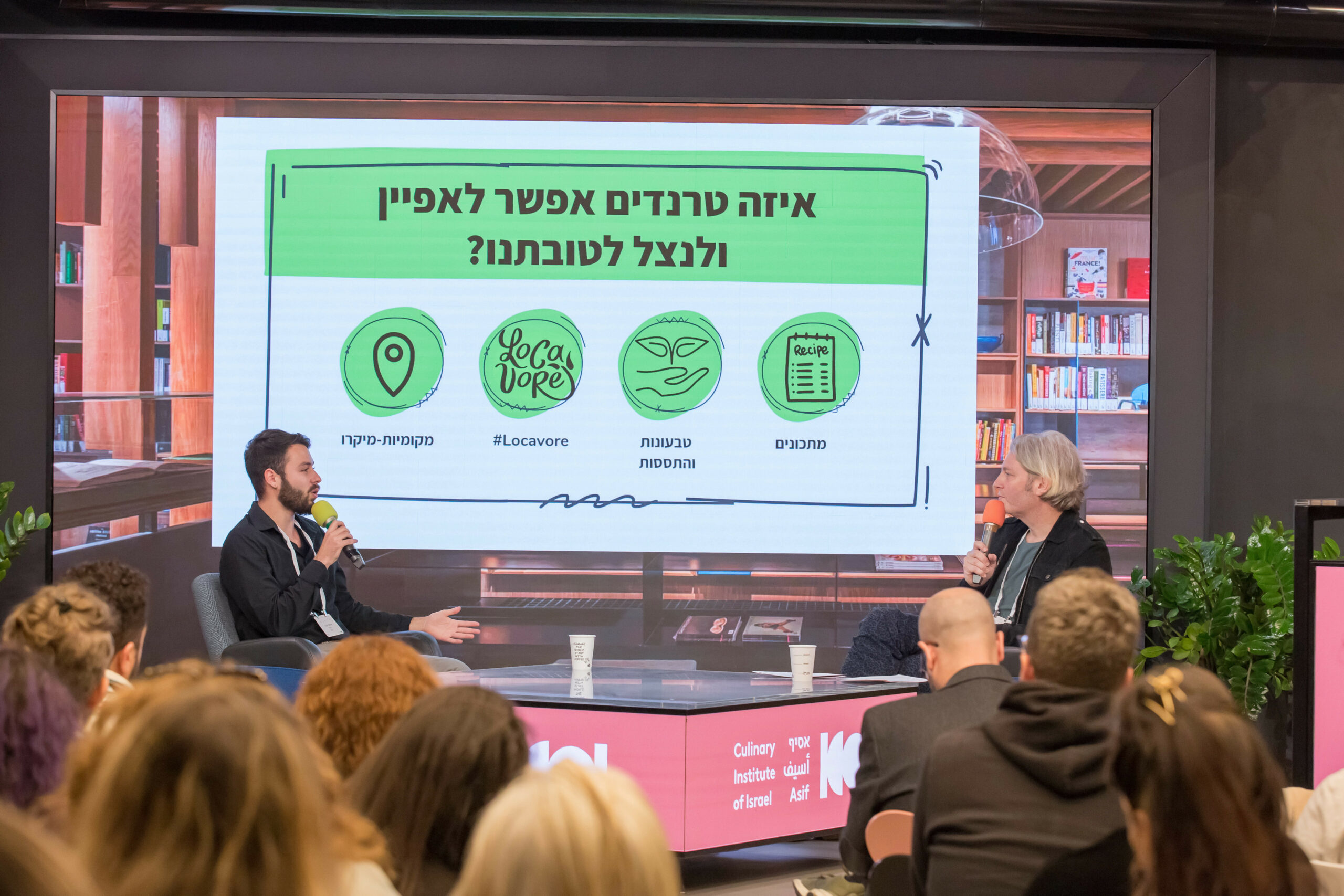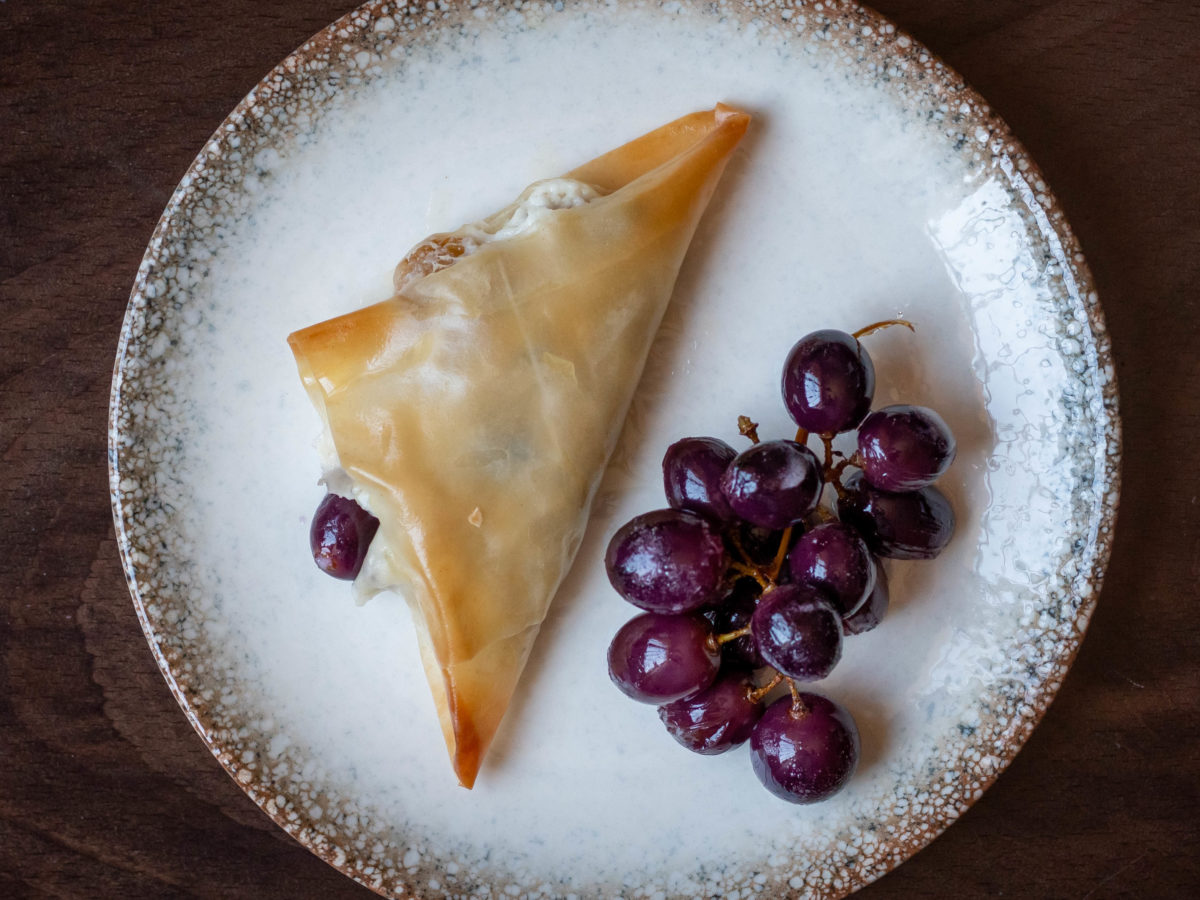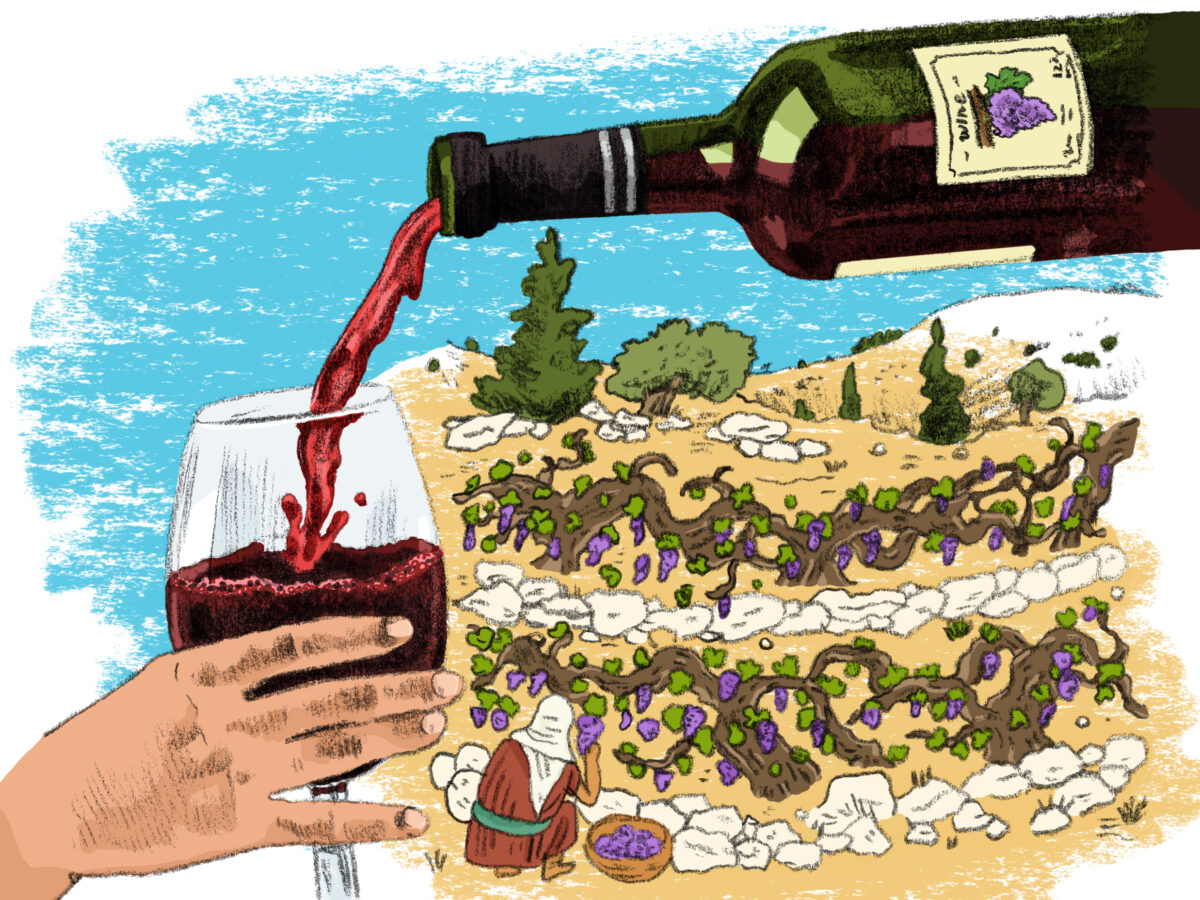Documentary TV, Local Food
We began with a discussion led by journalist Hila Alpert. Around the table sat Etty Ante-Segev, television, music and Israeli culture producer and editor, including the first television food docuseries made in Israel (“Gidi Gov Goes to Eat“); Hilla Medalia, film producer and director currently engaged in the production of a food documentary about local traditions in the Arab society for Makan channel (مكان 33) , under the direction of Dr. Muzna Bishara; Ofer Ein Gal, creator, director and editor of “We Are on the Napkin” and “Near the Napkin” for Kan 11; Shahar Segal, director, creator, businessman and restaurateur, Eyal Shani’s partner in The Better Guys group.
Watch the panel and check out key takeaways below.
- Alpert opened the discussion and spoke about the fact that during the mid-1990s, representations of food began to appear on the Israeli television screen. At first, these were short segments within other programs that dealt with the less serious side of food. This was part of a process in which the Israeli public learned to embrace the preoccupation with the individual, which until that point was considered not worthy enough to serve as a topic of discourse in the public sphere. It was during that time that local restaurants also went through a transition, seeing a departure from canteens and buffets and the introduction of fine dining.
- The television program “Gidi Gov Goes to Eat” was the first food docuseries made in Israel. Etty Ante-Segev said that the motivation for creating the program was not the food itself, but the desire to get to know the people who live in this country through food. Alpert asked whether the production of the show was directed by a sense of mission, to which Ante-Segev replied that “Precisely because we (the creators) are people who came from music, we understood the power of connecting people from different places and cultures. That’s why it was important for us to give representation to a variety of cultures and identities in Israel.”
- Shahar Segal spoke about the program “Food for Thought,” which he hosted with chef Eyal Shani: “Similar to our restaurants, the idea was that the food would primarily serve as a means for a conversation, and not as an end. This idea exists precisely between Eyal’s genius and charlatanism. His ability to talk and confuse the viewer or the diner who doesn’t understand if he’s talking about food, life, or sex.”
- The series “On the Napkin” began as a documentary about Israeli restaurants abroad. Ofer Ein Gal said that it was very difficult for them to try and define what local cuisine is within Israel, so they chose to travel abroad in order to get a perspective: “We wanted to define the local cuisine by trying to understand how it is perceived from the outside, and in particular through those who emmigrated from Israel abroad” He shared. “Later we realized that it is more interesting to talk about local cuisine precisely where it is local, and not where it echoes what others think local cuisine is elsewhere.”
- Regarding how Israel’s small scale impacts the local documentary scene, Ein Gal replied that “your personal point of view is the way in which you can innovate in such a small space. We began the fourth season after the riots of May 2021, when there was a feeling that our society was on the verge of complete breakdown. We tried to show how the dialogue continues on the Israeli plate, while breaking down everywhere else.’
- Hilla Medalia, who’s engaged in the making of a food documentary for the first time in her professional life, claimed that food makes it possible to reach a discourse on the most sensitive and painful aspects of our society. The program seeks to forge access to people and culinary practices, but also to the complicated politics that stem from them.
- Segal added: food has taken over prime time in an almost ridiculous way. There is a crazy inflation of cooking shows. According to Segal, this is because Israel is a place that requires comfort. Segal agreed with the statement that making food documentaries is a challenge in a small place like Israel (“Gidi Gov is going to eat? Where can he possibly go?”), and that there are not enough niches that have not yet been talked about (“Apart from Palestinian cuisine, which is a very politically charged niche”). Also, Segal claimed that there is a similarity between Israeli food and Israeli tech – both are driven by audacity, passion and ambition. This, according to Segal, should be the angle from which to discuss the local cuisine.
- Regarding the comparison between the local food documentary in Israel and the same genre on Netflix, Segal said that both markets should not be compared. He argued that Netflix’s small niche is still worth the effort, while the local market is too niche.
- The panel agreed that today’s prominent competitor for food documentaries are the social networks. With their help, the general public largely became the main documenter of the food culture, for better or worse. Alpert added that the difficulty that arises from this is the creation of original food. Viewing other cooking pages will create fixed views, and solidify them. She recommended that food enthusiasts search for their unique voice by looking at Instagram pages covering other disciplines such as dance, poetry and painting.
- Regarding the importance of creating documentaries, Medalia (who produced the political documentary series “Oslo Diaries,” among others) claimed that the documentary has the power to embed messages in the public consciousness.
- Emotion is what leads the creation of successful film and television pieces. It is what connects the viewers to the story. Emotion can also be laughter and joy, not just sadness and sorrow.
- On the difference between a food docuseries and a food reality TV show, Alpert concluded: In a docuseries, food is used as a tool, whereas in a reality show, it is the end goal.”
The Tip of the Fork: Local Food Culture on Social Media
During the second part of the lunch session Oren Luxenburg, a chef who works as a financial management consultant for restaurants and cohost of the “Talking Is Not Fattening” podcast, chatted with and Itamar Aviv, a TikTok expert and CEO of Toks, a company specializing in creating Tiktok videos for companies and brands.
Watch the recording of the conversation and check out a summary below.
- Luxenburg began the conversation by describing his use of podcasting as a messaging tool. In this media, consumers actually appreciate attention to detail. However, the growing scope of content consumers means that it is now more difficult to capture the audience when it comes to long-form messages. Social networks, with TikTok in the lead, are on the top in the popularity index. TikTok allows content to be delivered to a huge audience from all over the world, but one that is impatient.
- During the conversation, the two presented the “new Tiktok user guide,” through which they sought to clarify how Tiktok should be used in order to convey messages aimed at documenting, preserving and promoting the local food culture traditions.
- In Aviv’s view, TikTok is competing with the content networks and not the social networks, that is, it should be seen as equivalent to Netflix and Channel 12 and not Facebook or Instagram. He explained that the difference stems from the fact that the content can reach everyone. Unlike the social networks that publish the content among the followers of the page, TikTok publishes among those who watched, commented, or liked similar content to the one that was published. Aviv expanded on this and said that although there is a cloud of negativity around it, TikTok offers a huge variety of content. Luxenberg strengthened that claim and said that for him Tik Tok has replaced sources of knowledge consumption and education. “I saw a video on TikTok” is the new “I read an article”.
- As creators, one of the biggest challenges is the competition for the viewer’s attention. In Tiktok the competition is against everyone. Among the endless scrolling, video creator must catch the viewer’s attention in seconds.
- The variety of content on TikTok is endless. One of the ways to attract a regular audience is to tell the story and connect it to the creator’s personal story. “The personal is the universal.”
- Tiktok enables tremendous global exposure. Recipes that go viral on TikTok become global trends. The feta pasta trend on TikTok even caused a global shortage of feta cheese.
- One of the biggest trends Tiktok brought with it is authenticity. Unlike Instagram, where everything is pretty and defined, Tiktok presents authentic moments, not too staged. “It’s okay if we spilled some sauce while taking pictures, that’s part of the point.” A video that is too polished will alienate the viewer, who will not feel connected.
- The videos must differentiate between what is and isn’t important. The recipe does not need to show every step. You need to give a general picture, direct the viewer, inspire and expose them to new worlds.
- Notable trends on TikTok: short 30-second recipe videos; veganism and fermentation; food preservation; sourdough bread; #LOCAVORE (nutrition based on local food only); Microlocality (presenting the culture of different groups in different places).
- Tiktok is becoming a visual search engine. Among young people, and in particular Gen Z, TikTok is becoming the default search engine. Last December, a Globes reporter checked and found that Tiktok provides a successful alternative to Google (“we tried to replace Google with Tiktok for one week, and it worked better than we thought” / Nevo Trabelsy, December 17, 2022, Globes).
- “Make TikTok Not Ads” – TikTok’s slogan makes it clear: for us, the content is at the center, and therefore the creator’s ambition should be to create content value for the viewer. The creator must ask themself what will create identification and what can move the viewer into action.
- TikTok has its own language, and the best way to understand this is to start watching and understanding together with the algorithm what works for you. Then jump into the water and start taking videos. The feedback will be immediate – within one day you will see if the video succeeded or failed.
- We watched five videos from prominent TikTok pages that showcase food and locality. Each of the videos presented a different and unique style and managed – each in its own unique way – to convey interesting, concise, effective and fast content. By analyzing the videos, the two compiled a list of characteristics for success of messaging on TikTok:
- In the past, we were used to the fact that every complex story has a beginning, middle and end. Tiktok doesn’t need that. The pace requires focusing on the story’s main message, and often starts from the end.
- It is best to show the final result as the first image of a recipe; use stimulating sounds and hard cuts.
- In a Tiktok recipe, there is no time for going in too much depth, such as giving quantities or special instructions.
- In a TikTok video, the creator’s charisma, the interaction and the sounds are of fundamental importance.
- The video should be continuous, without stops or quiet moments.
- Tiktok video collection can connect to a wider story. Sometimes at a quick glance the video seems nonsensical or casual, but getting to know the wider story can reveal additional layers.
- However, one of the main purposes of TikTok is entertainment. That’s why it’s important to remember that silly videos also have a place.
- Tik Tok knows what the videos are about based on the photo, the text and the comments. The algorithm knows whom to distribute the video to, based on interests and viewing habits.
- Creators with a love for long words also have a place on TikTok. It is possible, for example, to read a section against the background of a video, which can connect directly or indirectly to the content of the text. Separation between the sound medium and the visual medium is acceptable and can also produce good Tiktok videos.


